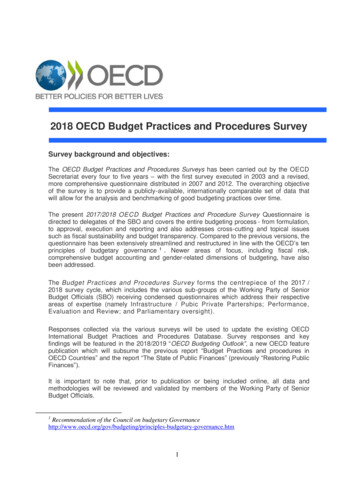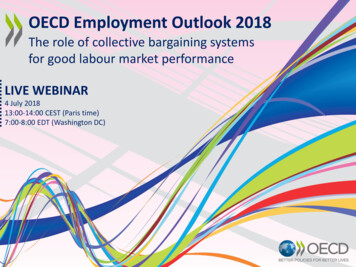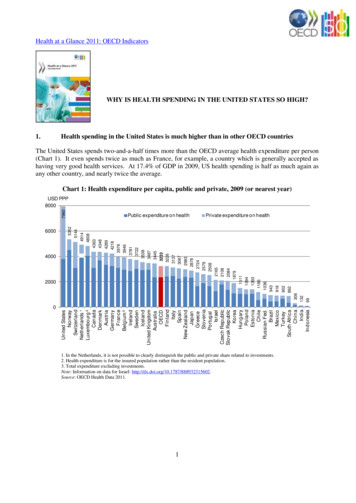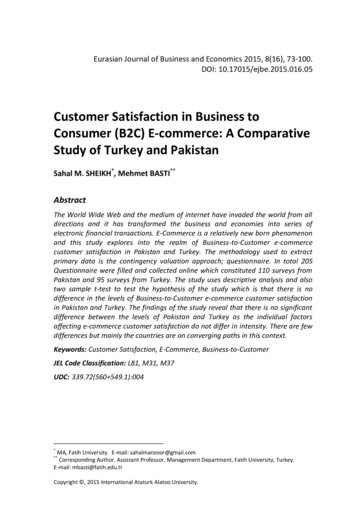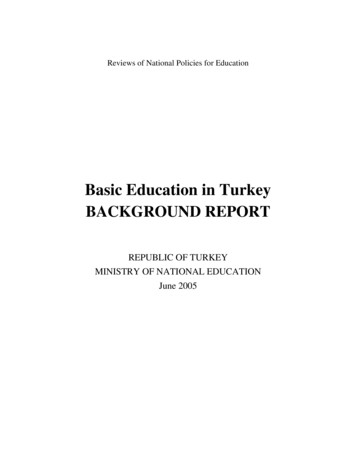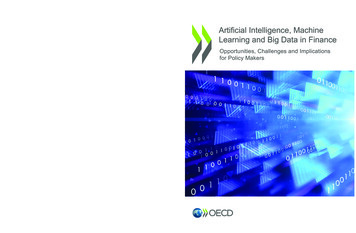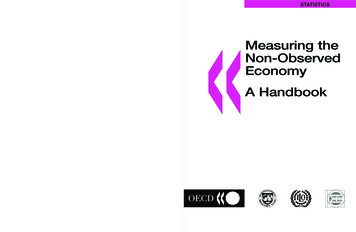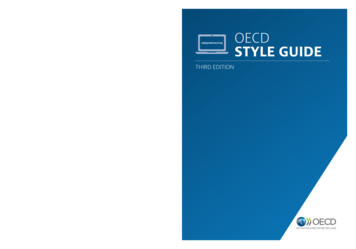
Transcription
Monitoring and Evaluation FrameworkOECD DUE DILIGENCE GUIDANCEFOR RESPONSIBLE SUPPLY CHAINS OF MINERALSFROM CONFLICT-AFFECTED AND HIGH-RISK AREAS
Please cite this publication as:OECD (2021), Monitoring and Evaluation Framework: OECD Due Diligence Guidance forResponsible Supply Chains of Minerals from Conflict-Affected and High-Risk AreasCo-funded by the European UnionPhoto credits: Luca Maiotti OECD 2021This work is published under the responsibility of the Secretary-General of the OECD. The opinionsexpressed and arguments employed herein do not necessarily reflect the official views of the OECD orof the governments of its member countries or those of the European Union.This document and any map included herein are without prejudice to the status or sovereignty over anyterritory, to the delimitation of international frontiers and boundaries and to the name of any territory,city, or area.MONITORING AND EVALUATION FRAMEWORK OECD 2021
3Organisation for Economic Co-operation and Development (OECD)The OECD is a unique forum where governments work together to address the economic, social andenvironmental challenges of globalisation. The OECD is also at the forefront of efforts to understandand to help governments respond to new developments and concerns, such as corporate governance,the information economy and the challenges of an ageing population. The Organisation provides asetting where governments can compare policy experiences, seek answers to common problems,identify good practice and work to co-ordinate domestic and international policies.The OECD’s work on responsible business conduct (RBC) is delivered through the OECD Centre forResponsible Business Conduct (RBC Centre). The RBC Centre, which is part of the OECD Directoratefor Financial and Enterprise Affairs, works with governments, business, workers and civil society topromote the implementation of the OECD Guidelines for Multinational Enterprises and related RBCstandards.The OECD Due Diligence Guidance for Responsible Supply Chains of Mineralsfrom Conflict-Affected and High-Risk AreasThe OECD Due Diligence Guidance for Responsible Supply Chains of Minerals from Conflict-Affectedand High-Risk Areas (hereinafter the “DDG”) provides step-by-step recommendations endorsed bygovernments for globally responsible supply chains of minerals in order for companies to respect humanrights and avoid contributing to conflict through their mineral or metal purchasing decisions andpractices. The OECD DDG may be used by any company potentially sourcing minerals or metals fromconflict-affected and high-risk areas, and is intended to cultivate transparent, conflict-free supply chainsand sustainable corporate engagement in the minerals sector. The OECD Council adopted theRecommendation on Due Diligence Guidance for Responsible Supply Chains of Minerals from ConflictAffected and High-Risk Areas on 25 May 2011 based on a proposal from the Development AssistanceCommittee (DAC) and the Investment Committee. More information on the OECD’s work in the miningsector can be found at: http://www.oecd.org/corporate/mne/mining.htmNotes on the Development of the Monitoring & Evaluation FrameworkThe development of this Monitoring & Evaluation Framework (M&E Framework) was premised on theOECD’s terms of reference, which had involved extensive prior stakeholder input over a period of 18months. Further input and guidance was received by the OECD’s Secretariat at each step of the M&EFramework’s development. The M&E Framework was critiqued by an Informal Advisory Group ofacademic and civil society representatives. Leading theory was applied to the problem at hand,including systems theory, game theory, and literature specific to the problematic of minerals associatedwith conflict and adverse impacts.The basic characteristics of minerals markets were considered, as well as precedents involving themeasurement of policy implementation. Upon being operationalised, the guiding specifications andparameters in the form of particular research methods and indicators were tested through example casestudies, providing a perspective of how this M&E Framework is to be applied. For this reason, severalexamples spanning indicators and data sources were drawn from experience implementing the DDG inthe Democratic Republic of the Congo. These should be considered indicative as specific national andsub-national data sources will be considered for the deployment of the M&E Framework in selectedcountries.MONITORING AND EVALUATION FRAMEWORK OECD 2021
5AcknowledgementsThis M&E Framework was prepared by Dr. Chris N. Bayer and Gerard van der Burg, representingDevelopment International e.V. (DI) and IMPACT, respectively, under the direction of Luca Maiotti,Benjamin Katz, Hannah Koep-Andrieu and Tyler Gillard (OECD Centre for Responsible BusinessConduct). Design and communications support were provided by Roxana Glavanov and Ariane Rota.On behalf of DI, the Framework was critiqued by Dr. Derrill Watson (Tarleton State University), Dr.William Bertrand (Tulane University), Lawrence Heim (CCRcorp), Bryanna Frazier (DI), Jesse Hudson(DI), Juan Ignacio Ibañez (DI), and Eliana Gonzalez Torres (DI). For IMPACT, Joanne Lebert and KadySeguin served as expert contributors, Carmen Teichgraber as the project manager, with contributionsalso made by Dr. Anthony Goerzen and Luke Fiske of Queen’s University.The design of this M&E Framework was further critiqued by the ad-hoc Informal Advisory Group (IAG),comprising the following individuals: Catherine Anderson (OECD), Steven van Bockstael (University ofGent), Darin Christensen (University of California, Los Angeles), Dr. Jose Diemel (Raw ResourceSolutions), Perla Ibarlucea (OECD), Benjamin Krause (University of California, Berkeley), Jocelyn Kelly(Harvard University), Ken Matthysen (International Peace Information Service), Ben Miller (CDACollaborative), Nene Morisho (Pole Institute), Josaphat Musamba (Center for Human Security Bukavu),Delphin Ntanyoma (Erasmus University), Dr. Dominic Parker (University of Wisconsin-Madison), Dr.Ben Radley (University of Bath), Dr. Martin Schleper (University of Sussex), Michal Shinwell (OECD),Dr. Nik Stoop (University of Antwerp), Dr. Marijke Verpoorten (University of Antwerp), Dr. ChristophVogel (University of Zurich), and Michelle Westermann-Behaylo (University of Amsterdam).Further, the authors wish to thank the Multi-stakeholder Steering Group of the OECD ResponsibleMinerals Implementation Programme (MSG) as well as constituent organisations of MSG members,and in particular Olivier Bovet (State Secretariat of Economic Affairs of Switzerland), Leah Butler(Responsible Minerals Initiative), Olivier Demierre (MKS PAMP GROUP), Guus Houttuin (EuropeanExternal Action Service), Natalia Uribe (Alliance for Responsible Mining) and Annie Signorelli (AppleInc.) for their substantive feedback on the Framework draft.MONITORING AND EVALUATION FRAMEWORK OECD 2021
7Table of contentsAcronyms and Abbreviations11Overview15Glossary191. Objectives and Development of the M&E Framework232. OECD Due Diligence Guidance253. Typology of peacebuilding interventions29NotesNotes1.1. M&E Framework Objectives1.2. M&E Framework Development2.1. Five steps of Due Diligence3.1. Withdrawal of the resources for war3.2. Economic action3.3. Culture of peaceNotes1722232325303132334. Theory of change355. The impact blueprint496. M&E Framework514.1. Assumptions4.2. Framework4.3. HypothesesNotes5.1. Dimensions of Impact5.2. Results Framework6.1. Monitoring vs. Evaluation6.2. M&E Periodicity6.3. Primary vs. Secondary Data, Levels of Rigour6.4. Attribution vs. Contribution6.5. Identification of Data and Methodological GapsNotesMONITORING AND EVALUATION FRAMEWORK OECD 2021353743474950515454555759
8 7. Evaluation plan618. Monitoring plan937.1. Methods7.2. Key Questions7.3. Types of Data Consulted7.4. Evaluation Sections7.5. Evaluation SummaryNotes6161626387928.1. Methods8.2. Key Questions8.3. Monitoring Summary939397References99TablesTable 1.1. Due Diligence Programme (DDP) criteria for M&E Framework studiesTable 2.1. Classification of metals and relevant DDG supplementTable 3.1. Peacebuilding in settings of conflict and fragility – common theories of changeTable 5.1. Results dimensions and descriptionsTable 5.2. Results frameworkTable 6.1. Monitoring vs. Evaluation, attribution vs. contributionTable 6.2. Primary vs. secondary data sourcesTable 6.3. Type of evaluationTable 6.4. Ultimate outcome dimensions treated by evaluationTable 6.5. Evaluation process indicatorsTable 7.1. Evaluation, key questionsTable 7.2. Annex II Adverse Impact indicatorsTable 7.3. SEC indicatorsTable 7.4. Minerals trade indicatorsTable 7.5. DDP indicatorsTable 7.6. Incidents detected vs followed-up vs mitigated through each in-scope DDPTable 7.7. Downstream Step 5 indicatorsTable 7.8. Downstream supply chain actor classificationTable 7.9. Upstream Step 5 indicatorsTable 7.10. Upstream supply chain actor classificationTable 7.11. Global DDG context indicatorsTable 7.12. In-scope context profile domainsTable 7.13. Quantitative measures of DDP quality and scaleTable 7.14. Qualitative measures of DDP quality and scaleTable 7.15. Assessment related to hypothesis clustersTable 7.16. Evaluation, further key questionsTable 7.17. Evaluation, longitudinal questionsTable 7.18. Evaluation FrameworkTable 8.1. Key Monitoring questionsTable 8.2. Summary monitoring-indicatorsTable 8.3. Monitoring indicators for Annex II Adverse Impact risksTable 8.4. Monitoring indicators for Socio-Economic ConditionsTable 8.5. Monitoring indicators for in-scope CAHRA ContextsTable 8.6. Monitoring 586878788888990939394969798MONITORING AND EVALUATION FRAMEWORK OECD 2021
9FiguresFigure 1. Thematic scope of M&E FrameworkFigure 4.1. Theory of changeFigure 4.2. Due diligence decision tree (ToC)Figure 4.3. Immediate level outcomes (ToC)Figure 4.4. Intermediate level outcomes (ToC)Figure 4.5. Ultimate level outcomes (ToC)Figure 4.6. DDP ultimate outcomesFigure 5.1. Theory of Change linked to the results framework and to the hypothesesFigure 6.1. Monitoring vs. evaluationFigure 6.2. Attribution or contribution between levels of actionFigure 7.1. Assessment sections as related to the Theory of ChangeFigure 7.2. Units of analysisFigure 7.3. Due Diligence Programmes and relevant impactsFigure 7.4. Company DD and purchasing modesFigure 7.5. Company DD and purchasing modesMONITORING AND EVALUATION FRAMEWORK OECD 2021153738404142424953566465727883
11Acronyms and Abbreviations3T3TGACLEDAOTin, Tungsten, TantalumTin, Tungsten, Tantalum and GoldArmed Conflict Location & Event Data ProjectAreas of OperationARMAlliance for Responsible MiningASMArtisanal and Small-scale MiningCAHRAsCCAConflict-Affected and High-Risk AreasCausal Contribution AnalysisCFSPCommon Foreign and Security PolicyCMRTConflict Minerals Reporting Template (RMI)COOCRAFTCountry of OriginCode of Risk-Mitigation for Artisanal and Small-ScaleMining Engaging in Formal TradeCSOCivil Society OrganisationDACResponsible Business ConductDALYDDDisability-Adjusted Life YearDue DiligenceDDGOECD Due Diligence Guidance on ResponsibleSupply Chains of Minerals from Conflict-Affected andHigh-Risk AreasDDMDue Diligence MineralsDDPDue Diligence ProgrammeDIDMCCDRCDevelopment International e.V.Dubai Multi Commodities CentreDemocratic Republic of the CongoMONITORING AND EVALUATION FRAMEWORK OECD 2021
12 EITIExtractive Industries Transparency Initiativee.g.Exempli gratiaFCPAForeign Corrupt Practices Act (U.S.)GAOGovernment Accountability Office (U.S.)GEMGeneral Elimination MethodologyGDPGross Domestic ProductGNIGross National IncomeHHIHarvard Humanitarian InitiativeHIIKHeidelberg Institute for International ConflictResearchHRWHuman Rights WatchIAGInformal Advisory GroupICFInner City Fundi.e.Id estIEPInstitute for Economics & PeaceILOInternational Labour OrganizationIPISInternational Peace Information ServiceKSTKivu Security TrackerKYCKnow Your CounterpartyLBMALondon Bullion Market AssociationLMELondon Metal ExchangeLSMMedium and Large-scale MiningM&EMonitoring and EvaluationMONUSCONCPsn.d.NGOnon-DDMUnited Nations Organization Stabilization Mission (inthe DRC)National Contact Points (OECD)not datedNon-Governmental Organisationnon-Due Diligence MineralsMONITORING AND EVALUATION FRAMEWORK OECD 2021
13NONIEThe Network of Networks on Impact EvaluationOECDOrganisation for Economic Co-operation andDevelopmentOEMOFACOriginal Equipment ManufacturerOffice of Foreign Asset Control (U.S.)OHSOccupational Health & SafetyRBCResponsible Business ConductRCOIReasonable Country of Origin InquiryRCTRandomised Control TrialRJCResponsible Jewellery CouncilRMIResponsible Minerals InitiativeSCSupply ChainSDSpecialized DisclosureSECSICSocio-Economic ConditionsStandard Industrial ClassificationSORSmelter or RefinerS&PStandard & Poor'sTOCTheory of ChangeTORTerms of ReferenceUAEUnited Arab EmiratesU.K.United KingdomUNUnited NationsUNDPUnited Nations Development ProgrammeUNICEFUnited Nations Children's FundUNITARUnited Nations Institute for Training and ResearchU.S.WGCWGIUnited States of AmericaWorld Gold CouncilWorldwide Governance IndicatorsMONITORING AND EVALUATION FRAMEWORK OECD 2021
15OverviewThe OECD Due Diligence Guidance for Responsible Supply Chains of Minerals from Conflict-Affectedand High-Risk Areas (DDG) recognises the private sector as a critical force and change agent that caninfluence the well-being of societies, and as bearing a particular responsibility when operating in orsourcing from conflict-affected and high-risk areas (CAHRAs). By conducting due diligence and makinginformed purchasing decisions, the private sector can avoid contributing to serious human rightsabuses, curtail revenue to armed groups and organised crime, and avoid links with financial crime. Itcan also help countries and communities benefit from their natural resources.As due diligence matures and grows to cover mineral supply chains across the globe, policymakers,stakeholders, and industry are looking for data to inform their decision-making. The application of thisMonitoring and Evaluation Framework (M&E Framework) will improve understanding of how duediligence is being implemented and if it is helping to achieve the aims of the DDG — and, if not,why. Like most policy interventions, to date the results of due diligence in mineral supply chains appearmixed, with progress, shortcomings and ambiguous outcomes spread across multiple dimensions. Thisis where the real value of the M&E Framework lies; to make sense of the mechanisms by which thepolicy environment and uptake of due diligence bring about impacts, particularly in mineral producingcountries and communities. The aim, in turn, is to generate actionable data that can helpstakeholders scale up what’s working and address what isn’t.How does the M&E approach work?The M&E Framework uses a theory of change to articulate the process through which corporateuptake of the DDG affects the market for responsibly sourced minerals and, in turn, influencesthe prevalence of adverse impacts and socio-economic conditions in mining communities. Thetheory of change also includes contextual factors that may drive, hinder or otherwise influence theimplementation of due diligence.Figure 1. Thematic scope of M&E FrameworkAnnex II Adverse ImpactsDegree of Corporate DDG UptakeMarket Dynamics &Direct EngagementSocio-Economic ConditionsInternational levelSource: Author’s own workMONITORING AND EVALUATION FRAMEWORK OECD 2021Production level
16 The framework relies on several studies to collect data for each part, or node, of the theory ofchange. For example: studies on context will collect information on regulatory developments or the level of informalityin supply chains; studies on uptake will examine companies’ implementation of specific due diligence practices; studies on the market for responsible trade in minerals will look at the performance of duediligence programmes and relative volumes of responsibly traded minerals; studies on impacts will aggregate data on the incidence of serious human rights abuses orarmed conflict in producing countries, among many other indicators.Comparing the results at each node will then enable investigation of the relationships betweenthem. Each study outlines methodologies, indicators, and data sources to generate evidence-basedconclusions.It may not be possible to isolate and estimate the effect of the DDG on specific outcome dimensionswith quantitative precision. The framework will, however, collect a significant amount of data thatcan affirm (or call into question) the theory of change and its underlying assumptions. Theusefulness of the framework will emerge most saliently from the picture it will build of specific duediligence topics across the dimensions of the theory of change. Consider the issue of tax payments:The framework collects data on this topic at every node along the theory of change, starting with publicfinancial management performance, through to companies’ and due diligence programmes’transparency on tax payments, and finally to receipts by governments. Similarly, the framework helpsinfer relationships between different parts of the theory of change on issues as diverse as de-risking,opportunities in the formal economy and decent work deficits. The studies will therefore not only helpidentify where there are shortcomings with implementation, but also the most impactful points of entryfor addressing such shortcomings and enhancing existing positive outcomes.More promising, the level of detail of the framework’s findings is projected to significantlyimprove over time, due both to the increased quality of corporate self-reporting necessitated byregulation and market requirements as well as the increased confidence made possible by datacollected over multiple cycles. The framework will also allow for interesting comparisons to be madeof implementation between different regions, for example, between producing countries with significantexperience in implementation and those where companies are just beginning to conduct due diligence.Ultimately, through these distinct analytical lenses, the framework aims to provide actionableinformation for stakeholders: for policymakers to continue stitching together a global rules-based system for responsiblemineral supply chains; for industry, market makers and exchanges to improve uptake of the DDG, and strengthen theincentives for doing so; and to empower civil society organisations with data that allows them to hold companies andgovernments accountable, ensure that due diligence is context-sensitive and help mineralproducing communities reap the benefits of improved governance of the sector.How will the rollout work practically?The OECD will supervise deployment of the framework in several selected countries and supply chains.Pursuant to its purpose of monitoring and evaluating implementation of the DDG, the M&E Frameworkhas a global geographic scope and is applicable to all minerals. A means to select country-supplyMONITORING AND EVALUATION FRAMEWORK OECD 2021
17chain pairs in which to deploy the framework is provided by the M&E framework’s forthcomingcompanion handbook 1. The OECD will continue to liaise with stakeholders, in particular partnerorganisations, independent researchers, companies and industry associations collecting data onmineral supply chains, to promote a harmonized approach to impact measurement and addressidentified data gaps through bespoke studies as necessary.Notes1Deploying the Monitoring and Evaluation Framework for the OECD Due Diligence Guidance onResponsible Supply Chains of Minerals from Conflict-Affected and High-Risk Areas: A Handbook.MONITORING AND EVALUATION FRAMEWORK OECD 2021
19GlossaryThe following operational definitions and typologies are applied in this document.Armed groups: As per the definition of the OECD (2016: 66) DDG: “non-state armed groups or theiraffiliates who: illegally control mine sites or otherwise control transportation routes, points where minerals aretraded and upstream actors in the supply chain; and/or illegally tax or extort money or minerals at points of access to mine sites, along transportationroutes or at points where minerals are traded; and/or illegally tax or extort intermediaries, export companies or international traders.”Artisanal and Small-scale Mining (ASM): “Formal or informal mining operations with predominantlysimplified forms of exploration, extraction, processing, and transportation. ASM is normally low capitalintensive and uses high labour-intensive technology” (OECD, 2016: 65).Attribution: The isolation and accurate assessment of “the particular contribution of an intervention,and ensuring that causality runs from the intervention to the outcome” (Leeuw and Vaessen, 2009: 21).Chain-of-custody: A record of the sequence of entities which have custody of minerals as they movethrough a supply chain.Conflict-affected and high-risk areas (CAHRAs): The OECD (2016: 66) characterises CAHRAs as“Areas identified by the presence of armed conflict, widespread violence, including violence generatedby criminal networks, or other risks of serious and widespread harm to people. Armed conflict may takea variety of forms, such as a conflict of international or non-international character, which may involvetwo or more states, or may consist of wars of liberation, or insurgencies, civil wars. High-risk areas arethose where there is a high risk of conflict or of widespread or serious abuses as defined in paragraph1 of Annex II of the DDG. Such areas are often characterised by political instability or repression,institutional weakness, insecurity, collapse of civil infrastructure, widespread violence and violations ofnational or international law.”Contribution: Where it is not possible to isolate and accurately determine attribution between theoutcome and an intervention (i.e. where it is not possible to quantitatively determine the degree/extentof causal attribution”), but one can make “chains of logical arguments that are verified” through a causalcontribution analysis, one may use the term contribution (Leeuw and Vaessen, 2009: 19, 31).Credible, independent 3rd party verifier: A qualified entity (which is not the producer nor the buyer),which validates that a given event, condition, or practice has or has not taken place in accordance withset standards.Direct or indirect support to armed groups: “‘Direct or indirect support’ to non-state armed groupsor public or private security forces through the extraction, transport, trade, handling or export of[minerals] includes, but is not limited to, procuring minerals from, making payments to or otherwiseMONITORING AND EVALUATION FRAMEWORK OECD 2021
20 providing logistical assistance or equipment to, non-state armed groups, public or private security forcesor their affiliates who: illegally control mine sites or otherwise control transportation routes, points where gold is tradedand upstream actors in the supply chain; and/or illegally tax or extort money or gold at points of access to mine sites, along transportation routesor at points where gold is traded; and/or illegally tax or extort intermediaries, export companies or international traders” (OECD, 2016:66).Downstream: The actors positioned in supply chain segments following the smelter/refiner tier of thesupply chain, up to and including original equipment manufacturers (OEMs), consumer-facingcompanies and retailers.Due Diligence (DD): OECD-premised due diligence constitutes: “an on-going, proactive and reactiveprocess through which companies can identify, prevent, mitigate and account for how they addresstheir actual and potential adverse impacts as an integral part of business decision-making and riskmanagement systems. Due diligence can help companies ensure they observe the principles ofinternational law and comply with domestic laws, including those governing the illicit trade in mineralsand United Nations sanctions” (OECD, 2016: 66-68).A sub-category of DD is “Supply Chain Due Diligence,” which the OECD defines as follows: “Withspecific regard to supply chain due diligence for responsible mineral sourcing, risk-based due diligencerefers to the steps companies should take to identify, prevent and mitigate actual and potential adverseimpacts and ensure that they respect human rights and do not contribute to conflict through theiractivities in the supply chain” (OECD, 2016: 70).Due Diligence Minerals (DDM): Minerals that are a product of a DDP (as defined below).Due Diligence Programme (DDP) 2: At a minimum, a DDP is an initiative that invests in riskidentification, mitigation and/or harm remediation and meets all of the criteria in the table below.Individual upstream company due diligence initiatives are in-scoped as DDPs for the purposes of thisFramework if they feature the criteria set out in this typology. Measuring the quality of these in-scopeDDPs is performed in Chapter 7.4, Section D.Table 1.1. Due Diligence Programme (DDP) criteria for M&E Framework studies#1.2.3.4.5.6.DDP in-scoping criteriaIs comprised of at least one upstreammineral producing or trading actor.*Leverages collective/collaborative actionbetween actors party to the initiative.Makes and/or abides by a publiccommitment to conduct due diligence-relatedactivities on at least one Annex II AdverseImpact.Tracks events and/or grievances(“incidents”) at the mineral origin until pointof export linked to one or more ANNEX IIAdverse Impacts.Manages and responds to risks byconducting corresponding mitigationmeasures and/or procedures as per theOECD DDG.Consults stakeholders as part of the processto identify and follow up/mitigate incidents.ExplanationEngagement of the upstream, and mineral exploitation in particular,is a DDP focus.Collective action creates synergies otherwise not exploited and isimportant for influencing supply chains.Alignment with the DDG, and targeting at least one of its Annex IIadverse impacts is basic to in-scope DDPs.The identification of incidents at their point of origin is a prerequisitefor effectively responding to risks.A commensurate reaction, premised on the DDG, informs the degreeof DDG alignment.Stakeholder consultations enhances the ownership andaccountability of the operation.MONITORING AND EVALUATION FRAMEWORK OECD 2021
217.Has a system of controls and transparencyover the mineral supply chain in place,including of mineral trade and transactions,i.e. traceability or chain-of-custody systems.*8.Has in-scope practices and outputsassessed through credible, independent 3rdparty verification on a regular basis.*The best means of control and transparency within supply chains isa chain-of-custody system (see definition in Glossary). Without arobust chain-of custody system in place, the DDP is vulnerable tofraudulent misrepresentation of the origin of minerals among supplychain actors party to the initiative (fraud being a primary risk as perpoint 4 of Annex II).Independent 3rd party verification enhances the credibility andlegitimacy of the operation.Note: *DDPs that are not involved in the sourcing or purchasing of minerals are exempted from criteria 1, 7, and 8.Source: Author’s own workEvaluation: The systematic collection, examination and analysis of information that pertains to theTheory of Change and the implementation outcomes (immediate, intermediate and ultimate). Theresults of an evaluation provide stakeholders with the information they need to determine whether theinitiative is meeting its anticipated objectives.Grievance mechanism: A “mechanism allowing any interested party (affected persons or whistleblowers) to voice concerns regarding the circumstances of mineral extraction, trade, handling andexport in a conflict-affected and high-risk area. This will allow a company to be alerted of risks in itssupply chain as to the problems in addition to the company fact and risk assessments” (OECD, 2016:40 and 74).Illegal practices: Conduct in contravention of the national laws in which entities are operating.Leakage-in: The flow of non-DDM into supply chains designated as DDM.Market actor: A commercial enterprise that extracts, produces, trades, or consumes in-scope minerals.Medium and Large-scale Mining (LSM): “[M]ining operations that are not considered to be artisanalor small-scale mining” (OECD, 2016: 69).Monitoring: “The continuous assessment of the intervention and its environment” (FORMIN, 2006: 31).Non-Due Diligence Minerals (non-DDM): Minerals extracted from CAHRAs that have not beenverified whether or to what extent they contributed to human rights violations (Annex II Adverse Impacts,paragraph 1) and/or funded armed groups (Annex II Adverse Impacts, remaining paragraphs), i.e. donot have Due Diligence Minerals status.Upstream: The supply chain links from point of extraction (ASM, LSM) to and including the smelter orrefiner (SOR). This includes miners (artisanal and small-scale enterprises or medium and large-scalemining companies), local traders or exporters from the country of origin, transporters, internationaltraders of mined or recyclable metals and refiners.Traceability: The ability to query and verify the history, location, or application of an item by means ofdocumented, recorded identification. According to the DDG, at a minimum, the following information isrequired: mine of mineral origin;quantity and dates of extraction;locations where minerals are consolidated, traded or processed;all taxes, fees, royalties or other payments made to governmental officials for the purposes ofextraction, trade, transport and export of minerals;all taxes and other payments made to public or private security forces or otherarmed groups;identification of all actors in the upstream supply chain;transportation routes.MONITORING
Table 6.1. Monitoring vs. Evaluation, attribution vs. contribution 52 Table 6.2. Primary vs. secondary data sources 54 Table 6.3. Type of evaluation 58 Table 6.4. Ultimate outcome dimensions treated by evaluation 58 Table 6.5. Evaluation process indicators 58 Table 7.1. Evaluation, key questions 61 Table 7.2. Annex II Adverse Impact indicators 66

